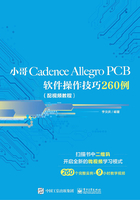
实例1 创建原理图器件

❶ 新建原理图库文件。选择菜单“File→New→Library”,新建原理图库文件“C:\library1.olb”,如图1-1所示。

图1-1 新建原理图库文件
技巧:建议将此原理图库文件另存到项目对应的文件夹,以方便查找和管理。具体操作为:选中此原理图库文件,单击鼠标右键,在弹出的快捷菜单中选择“Save As”,选择好路径(见图1-2)并更改好文件名后,单击“保存”按钮即可。

图1-2 另存原理图库文件
❷ 选中“SCH_LIB.OLB”,单击鼠标右键,在弹出的快捷菜单中选择“New Part”,弹出设置器件属性对话框。填入相应的参数后,如图1-3所示。这里主要在“Name”文本框中填入器件的名称,在“PCB Footprint”文本框中填入对应的封装名称。单击“OK”按钮完成设置,如图1-4所示。

图1-3 设置器件属性

图1-4 设置器件完成
❸ 双击“K9F2G08U0M*”选项,进入绘制器件界面,如图1-5所示。

图1-5 绘制器件界面
❹ 选择菜单“View→Toolbar→Draw”,显示“Draw”工具栏,如图1-6所示。

图1-6 “Draw”工具栏
❺ 在默认情况下,界面背景的显示类型是点状,将其更改成线状可以方便绘制。选择菜单“Options→Preferences”,打开如图1-7所示的“Grid Display”选项卡,在“Grid Style”选项组中选中右侧的“Lines”单选按钮,单击“确定”按钮。设置完成后,界面背景的显示类型变成线状,如图1-8所示。

图1-7 设置“Grid Display”选项卡

图1-8 界面背景的显示类型变为线状
❻ 器件管脚示意图如图1-9所示,按照示意图绘制器件的丝印框即可。选择菜单“Place→Rectangle”,在界面中绘制一个矩形框,如图1-10所示。

图1-9 器件管脚示意图

图1-10 绘制矩形框
❼ 选择菜单“Place→Pin”,弹出设置管脚属性对话框。在“Name”文本框中输入管脚名,在“Number”文本框中输入管脚号,在“Shape”下拉列表中选择“Line”,在“Type”下拉列表中选择“Passive”,其他保持默认设置。设置完成后,如图1-11所示。单击“OK”按钮,放置管脚即可,如图1-12所示。其他管脚可以参考上述方式放置。

图1-11 设置管脚属性对话框

图1-12 放置管脚
技巧:
●建议设置栅格(Grid)为默认值100 mil。
●管脚名称不要重复,如果有多个管脚名为“NC”,则建议将其改为“NC1”“NC2”“NC3”……
●建议器件名称用常规字符设置,如数字、英文字母、下画线。
当然,也可以通过放置管脚阵列的方式一次性放置多个管脚,以方便创建。选择菜单“Place→Pin Array”,弹出设置管脚阵列对话框,并对下列参数进行设置。
●Starting Name:开始放置第一个管脚的名称。
●Starting Number:开始放置第一个管脚的管脚号。
●Number of Pins:需要放置管脚的数目。
●Increment:如将“Increment”设置为1,则当第一个管脚的管脚号为1,“Number of Pins”为3时,第一个管脚名为“D1”,后续管脚名按照“D2”“D3”的规律来放置。
●Pin Spacing:输入“1”,表示栅格间距为100 mil。
管脚阵列参数的设置结果如图1-13所示。

图1-13 管脚阵列参数的设置结果
通过管脚阵列的方式可一次性放置多个管脚,如图1-14所示。双击管脚,可更改管脚名和管脚号。例如,双击管脚1,在弹出的对话框中输入想要的参数即可,如图1-15所示。

图1-14 一次性放置多个管脚

图1-15 输入想要的参数
对于特殊管脚名称,如图1-16所示中的管脚8、管脚18,输入格式如图1-17所示。

图1-16 特殊管脚名称示意图

图1-17 特殊管脚名称的输入格式
在放置特殊管脚名称的管脚后,如图1-18所示。其他管脚根据上述操作放置即可,完成后如图1-19所示。

图1-18 放置特殊管脚名称的管脚

图1-19 放置完成所有管脚
❽ 若需要在器件中放置Text文本,则可以通过菜单选择“Place→Text”打开“Place Text”对话框,输入文字,如图1-20所示。如果需要更改文字的属性,则通过修改“Color”“Rotation”“Font”等参数即可完成。输入文字后,单击“OK”按钮并将其拖至器件中。单击鼠标右键,在弹出的快捷菜单中选择“End Mode”结束命令。在器件中放置完成的Text文本如图1-21所示。

图1-20 输入文字

图1-21 在器件中放置完成的Text文本
至此,原理图器件创建完成。